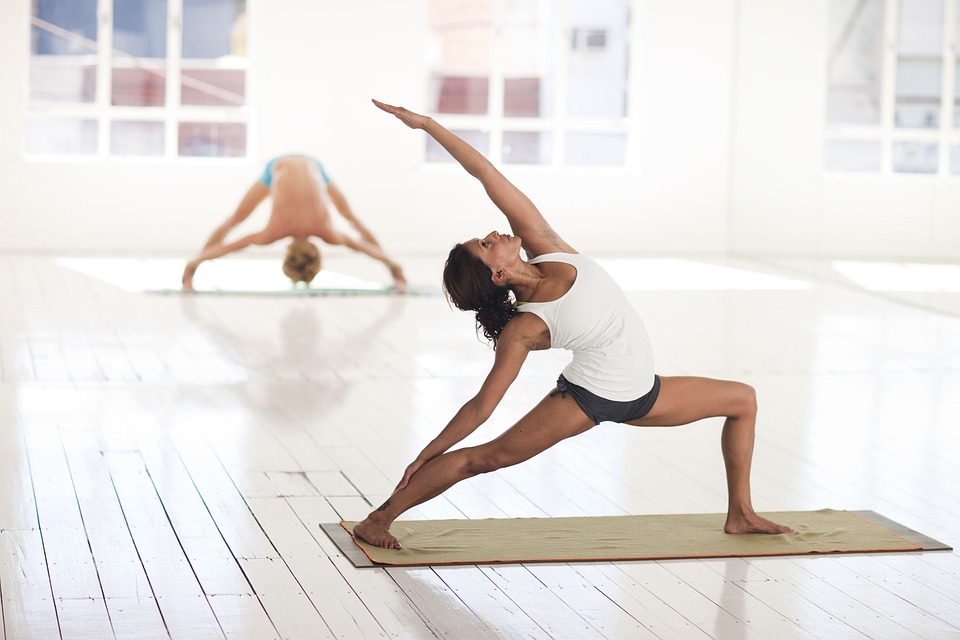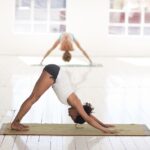Thinking of trying yoga? Have questions that are holding you back? You are not alone. What do I need to start yoga? What if I’m not flexible enough for it? What if I get hurt? Is it effective? How will it help me? What if I don’t measure up to everyone else in the class?
It is perfectly understandable to be apprehensive when trying something new, particularly concerning yoga, and questions and apprehensions are perfectly normal. Let’s tackle a few of the queries that come up most often to ensure that you are ready for your first lesson.
Here are 15 questions beginners frequently ask about yoga:
1. What is yoga?
Yoga is an ancient system of thought from India which dates back at least 5,000 years. Yoga’s origin can be traced back to the Sanskrit “yuj,” signifying unification or connection. By performing certain postures, breathing exercises, and meditation, yoga attempts to bring one’s body and mind together in harmony.
By practicing yoga, one can become more aware of themselves and develop a closer relationship with their inner self.
2. What are the benefits of yoga?
Yoga can provide advantages to all types of people, such as expectant mothers, children, and seniors, by having a positive impact on both the body and mind. Practicing yoga is more than physical exercise; it reduces stress, relaxes the mind, and nourishes the body. Research has demonstrated that yoga may increase one’s metabolic rate and decrease their chances of developing certain illnesses.
3. What if I’m not flexible?
No need to be limber to do yoga. By taking yoga classes on a regular basis, your body will become more limber, open, and mobile. Even if you are not physically limber, that does not mean that you cannot practice yoga. Yoga will increase your flexibility and muscular strength.
4. Are there different types of yoga?
Yoga is not just limited to one style or form of practice. You can divide yoga classes into two general categories: those that are lower intensity, such as gentle and restorative classes, and those that require more effort, including vinyasa and Ashtanga.
Classes that have a more relaxed pace involve more stretching and the poses are held for a longer time frame, whereas the classes that are more difficult and have a more intensive nature put more emphasis on flowy, equilibrium poses.
5. What if I don’t know how to meditate?
Honing in on meditation is not a simply task – in order to achieve a tranquil state of consciousness, one must entirely loosen up their body as well as their thoughts. It can be off-putting for a novice to try meditating, so go easy on yourself, don’t rate or anticipate, and getting into yoga is a fantastic way to get going!
6. What is Savasana?
Savasana is crucial in a yoga class as it is the moment where you reap the advantages from the class, both in terms of recovery and growth. Savasana provides a great chance to experience serenity, reduce worry, and unwind both mentally and physically.
7. Do I need to practice yoga every day?
It’s really up to you how often you practice. The clear conclusion is that if you perform yoga on a regular basis, you will experience a greater degree of good effects. It is optimal to dedicate two to three sessions of an hour each week to practice. Begin at a gradual pace and build up the amount of practice you do as you feel comfortable.
8. Do I need to wear something special to yoga?
Just put on whatever makes you feel relaxed and won’t stop you from moving. It isn’t essential for women to wear leggings and a tank top, nor is it needed for men to don athletic shorts, although they are the most common clothing alternatives.
When it’s time to purchase high-quality clothes, there are plentiful yoga brands accessible for both males and females.
9. What do I need to bring to yoga class?
It doesn’t matter what variation of yoga you do, usually all that’s necessary for the practice is a yoga mat and a bottle of water. A lot of studios possess yoga mats that can be borrowed or hired in case you do not possess one. It might be beneficial to bring a hand towel if you tend to perspire heavily.
10. Can I eat before my yoga class?
You should not consume food just before taking part in physical activity as is normal. Yoga can consist of twisting, bending and turning upside-down. A stomach filled to capacity can easily become disturbed during your exercise. It is advisable to consume a significant amount of water through the day so as to maintain your body hydrated, and to have a bite to eat two hours before the lesson.
11. What is “OM” and do I have to chant?
In yoga, OM is frequently referred to as the “noise of the Universe”. Some instructors encourage their students to chant OM together before and after the class to reorder their energies via sound resonance. Not all sessions involve chanting, and whether you choose to join in is entirely up to you. The more you engage in chanting, the more accustomed to it you become, but even just hearing the soundwaves produced can help you.
12. What if I don’t know the names of the yoga poses?
You don’t need to be familiar with all of the hundreds or even thousands of yoga postures. Pay attention to the guidance of your teacher and if necessary, turn to another yoga practitioner for a demonstration.
If your teacher uses a foreign language to name an exercise, they are speaking Sanskrit. Sanskrit, the language from ancient times, is the source from which many yoga postures got their names. You should take a look at A Quick Guide to Sanskrit, which provides an excellent summary of the positions and the literal translations in Sanskrit.
13. How is yoga different from other kinds of exercise?
A lot of individuals view yoga as an exercise to help lengthen the body’s muscles, develop suppleness, and maybe even boost strength. Yoga does not just offer physical benefits that you would receive from other forms of exercise, it also provides plentiful advantages for your mental state and spiritual practice.
In addition to physical exercises, this practice utilizes conscious breathing, stillness, alertness, purification methods, and bodily self-awareness. Yoga is more than just an exercise; it’s an entire way of life and an activity to take part in. It works to make your body healthy, but it also goes beyond that.
14. Do yoga teachers touch the students?
Many yoga teachers offer assists during class. These mild aids could be “manual” alignments or giving a student a yoga equipment. Assisting the student with adjusting their posture can help them achieve better results while doing yoga poses.
At the start of the lesson, instructors will generally tell their class that they will be providing physical support and they can choose to stay out of it if they prefer. If you don’t feel comfortable with physical contact, tell your instructor before the lesson begins.
15. What if I don’t want to start at a studio?
It is possible to kick off your yoga practice without going to a studio; many fitness centers and local community places offer courses. If you would rather not be in a crowded place, don’t worry. We are lucky to be able to take part in yoga classes over the internet so that we can exercise in our very own residence.
BONUS: How To Become a Yoga Teacher: A Beginners Guide
Before you make a decision to take part in a Yoga Teacher Training Program, take a moment to consider why you specifically want to become a yoga instructor.
There is no doubt that taking part in a course to become a yoga instructor is an incredibly rewarding experience. However, it is certainly no walk in the park. The trip is difficult and intense – there is plenty to be studied. We are discussing yogic postures, reflection, the concept of yoga, anatomy, and even some scientific research. You can’t possibly be a yoga trainer without comprehending human anatomy! You will delve into the industry of yoga, and learn how to promote your skills and secure jobs. It’s a large task, so it is beneficial to examine your options before going on a trip to India and taking on a full-time job.
Examining yoga can be expensive too, so it is important that you make sure you have the right motives. Before committing, take the time to answer the following queries.
Do you know yoga?
Before you begin any yoga instruction, consider what you already know about yoga. Do you really know what yoga is? We do not suggest that you need to be proficient in crow pose or be an expert at doing a headstand. You don’t need to fluently say all the poses in Sanskrit as you move through a vinyasa. You must be familiar with yoga and its mental attitude in order to be successful. Make sure you explain what the practice means to you personally.
For many people, yoga is a fitness class. It is quite valid that yoga enhances our physical condition and provides us with great health. Yoga is much more than just a workout; it is a complete practice which stretches far beyond the body’s muscles. The education you receive from a YTT goes much beyond a basic exercise session.
Yoga promotes a sense of equilibrium and serenity all through the body when practiced correctly. It revitalises your soul and rejuvenates your mind. In ancient Sanskrit, yoga means to harness, to yoke. It represents the union of mind, body and soul. Implementing yoga merges your breath, posture, and mental focus.
As a yoga teacher, it is your responsibility to inform your students about the different dimensions of yoga.
Yoga draws together science and spirituality. You don’t need to be an expert in this prior to engaging in yoga teacher training, but it is essential that you are ready to learn more concerning the physiology and anatomy of yoga.
Feeling intrigued? Right, next question.
Why do you want to become a yoga teacher?
Prior to enrolling in a yoga teacher training program, it is important for you to consider your own reasons for wanting to do so. The two main reasons why most yogis elect to train as a yoga teacher are:
- To become a yoga instructor : if you are curious or committed to making a career out of teaching yoga, then you will need to study a YTT. Although there is technically no law against teaching yoga without certification, it is much harder to get work without qualifying.
- To deepen your own practice: that’s right – you can study a YTT purely for your own benefit. You don’t actually have to become a yoga teacher! Studying a 200-hour YTT provides a comprehensive foundation for the practice of yoga. In addition to practising asanas, you will undertake training to develop your own meditation and pranayama skills.
It’s true! A large number of people who sign up for a yoga instructor certification program do not plan to teach yoga when they finish. You don’t have to become a full-time yoga instructor if you are curious about it.
Can anyone be a yoga teacher?
Absolutely. Becoming a yoga teacher necessitates rigorous physical and mental effort. On the other hand, it’s extremely empowering. Yoga is not a competitive sport. Yoga mats serve to accept and accommodate people from all walks of life, including those of different physical shape, size, background, gender and fitness level.
You should make sure to perform the research when you are able to fit it into your schedule.
Don’t let your concerns about your health or weak lower back stop you from moving forward. The core principle in yoga is to understand our individual capacities and modify yoga postures to accommodate our body’s particular needs. That goes for yoga teachers as well.
It is important to let your yoga instructor know if you have a chronic health condition, have had an injury, or have a problem spot.
You will need a good amount of mental perseverance to finish your Yoga Teacher Training since there is a lot of theory to learn.
How long does it take to become a yoga teacher?
Basically, one of the fantastic benefits of becoming a yoga instructor is that you can take as much time as is required.
Many aspiring yoga instructors choose to complete a 200-hour yoga teacher training program (YTT) on a retreat. This may be in your home country or overseas. The quickest route to becoming certified is to participate in a 15-day program. This level of intensity may not be suitable for everyone’s way of learning. The lengthiest YTT retreats are between three and four weeks. You will have a busy day and usually you will wake up early in order to partake in the pre-breakfast meditation and/or yoga. Over the course of the day, you will learn about many forms of philosophy, human anatomy, scientific topics, and how to teach students.
If you are unable to invest your time in a full-time yoga teacher training retreat you have two other options:
- You can study part-time at a school in your neighbourhood. On average, part-time study will take three to five months to complete. But, it might take up to one year.
- Alternatively, you can become a yoga teacher online by studying a remote YTT. More on that later!
Think realistically about the amount of time you can dedicate to your learning. It is best to dedicate more time to studying, but make sure you are putting in genuine effort. Attempting to absorb the material in haste might lead to not totally comprehending what you have studied.



